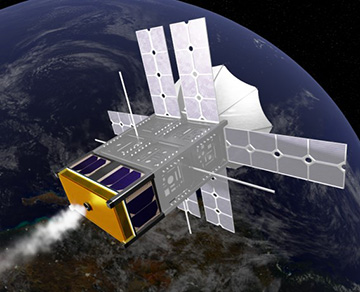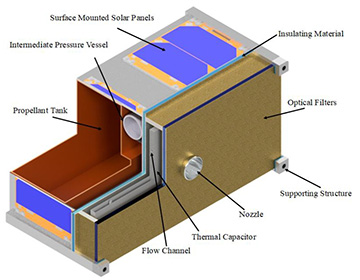
[Image: Courtesy of Howe Industries]
CubeSats—small, metal-box satellites that can be lofted into orbit as ride-alongs with other payloads—have opened up a range of new opportunities for low-cost inroads into space for academic experiments and business ventures (see “CubeSats: Tiny Platforms for Orbiting Optics,” OPN, January 2019). One disadvantage of the platforms, however, is that most CubeSats are essentially passive, as it’s been tough to find a way to cobble onto them a propulsion system that’s sufficiently small and powerful, yet safe enough not to endanger other payloads riding up to orbit on the same launches.
Howe Industries, a firm based in Scottsdale, AZ, USA, has looked back a few centuries to a potential alternative mode of propulsion for CubeSats: steam power. Under a US$225,000 Small Business Innovation Research (SBIR) grant from the U.S. National Science Foundation, the company has just presented the design for a system that would combine sophisticated optical filtering, photonic crystals, phase-change materials and water to create compact, light and safe propulsion for CubeSats and other nanosatellites. As the company eyes the next phase of the project, OPN caught up with is founder and CEO, Troy Howe, to learn about the project, the market and the next steps.
Before we dig into the ThermaSat system, tell us a bit about Howe Industries. The company seems to be involved in a number of interesting niche space projects.
I started Howe Industries in 2015, when I finished grad school and had come up with a few ideas that I wanted to pursue regarding power generation and space exploration. I had a couple of engineering clients and jobs I was pursuing, and was able to start up this company and start writing up proposals and sending them out to NASA, DOE and others.
My background is in mechanical engineering, with a strong emphasis on nuclear that has potential for space applications. And in 2017, Howe Industries won a NASA SBIR grant to explore a new type of nuclear thermal rocket fuel. And we did that project, and after our success with that, we were able to come up with other new concepts, in areas like nuclear electric propulsion, thermal electric power conversion and thermoelectric coolers.
Until now all of our stuff has been very nuclear oriented. So we tried to put our heads together and come up with something that looked a little more “near term.” That spawned the application for an NSF SBIR grant for ThermaSat—a solar-thermal propulsion system for CubeSats.
What has particularly excited you about CubeSat propulsion as an opportunity? Why is something like this needed to move CubeSats ahead?
The CubeSat revolution, as it’s called, is an interesting concept, because back in the day, people were launching these multi-ton communication satellites, and it was really restricted to huge companies or NASA. But once you have these small CubeSats, and the ability for them to “ride-share” on other launches or even go up on CubeSat-dedicated launches, there’s all sorts of capabilities that can be realized with the ingenuity of small businesses and new inventors. You don’t need to have a huge financial backing; you can just kind of say, I want to do my own communications or my own internet or my own cameras.
That opens up a lot of interesting avenues. But you’re very limited in your capabilities, because you have a very small payload. Having a propulsion system can change your acceptable altitudes; it can let you avoid debris; it can elongate your lifetime. So that further adds into the capabilities of these new tiny satellites.

Troy Howe.
Is there any way to quantify what sort of potential market we’re talking about in propulsion for CubeSats?
The CubeSat market overall growing at a very fast rate. It’s been projected to reach US$700 million in five years, but it looks like it could easily exceed that and go over a billion, based on plans for specific constellations that have been announced. Given that overall market size, we think that we could be conceivably selling as much as US$25 million in ThermaSat systems for CubeSat propulsion five years out, perhaps growing to US$50 million or more in subsequent years.
So it’s definitely an attractive market to us. Right now we mostly view ourselves as technical guys trying to make cool propulsion systems. But it seems like things are going in that direction, and hopefully we can be a part of it.
Walk me through the basics of how the ThermaSat system works, and where optical systems play a role.
There are basically two key elements that are really important to making the ThermaSat work, the optical system and the thermal capacitor system. The optical system works in a way similar to the greenhouse effect on Earth. When the sun illuminates the Earth with all these different wavelengths of light, the Earth heats up and tries to radiate that energy out in the infrared spectrum. But greenhouse gases in the atmosphere reflect that infrared energy back in. The result is that the incoming sunlight gets reduced by a small percent, but the infrared emission back into space gets reduced by a large percent, so it heats the temperature of the planet.
With ThermaSat, we kind of take that to an extreme and do it on purpose. The system has multiple layers of selectively transmissive filters that really block and reflect infrared light. So when the sunlight comes in, all the infrared gets reflected away. The visible and UV energy comes in, and heats the thermal capacitor. And as that capacitor tries to radiate that heat away—because there’s no other way for it to reject heat—the heat sees that reflective IR barrier, and it comes back in.
And that gets our operating temperature very high—above 1000 or 1100 K. That’s a lot hotter than you need to boil water, for sure; with rocketry, though, where you’re expanding gases, the hotter you get, the better your performance. And so that’s really what we wanted with the optics—to let us hit that high temperature level.
And you’re using photonic crystals to do this wavelength filtering?
Yeah, exactly right. Basically, there are two parts to the optical system. One is a gold-coated glass, on the outside of the thermal capacitor, which itself blocks a lot of the infrared. And then, the thermal capacitor itself is basically a tantalum can, containing the phase-change material.
On the outside, on that tantalum surface, is the photonic-crystal structure. Those are some very impressive surface features originally developed at MIT, and then spun off to a company called Mesodyne that we’ve been working with. And they can create tiny, tiny holes in a tantalum surface—a repeating pattern of micron-scale holes. And the long infrared wavelengths just can’t exist in those holes—they can’t be produced or emitted there, and if they try to come in, they bounce off. It makes the tantalum surface a selective emitter and a selective absorber. And that helps us absorb the short wavelengths, to heat up the thermal capacitor, and reflect the long wavelengths.
OK—so we’ve got an optical system that traps infrared radiation inside, to boost the temperature. Tell us about the thermal capacitor side of the system, which actually stores that energy.

Schematic of the ThermaSat system. [Image: Courtesy of Howe Industries]
In our latest design, the capacitor is basically just a steel brick filled with calcium iodide salt. As that heats up, it’s kind of “trickle-charging” with thermal energy from the sun—as the temperature rises, the salt starts to melt. It stays at a constant temperature while it goes from solid to liquid, and it gathers a lots and lots of heat from the sun.
Once that’s completely melted, still at 1000 K, that’s when we introduce our propellant—just water. The water extracts that heat and turns rapidly to steam, which expands and pushes out the back, and propels the spacecraft forward.
So the phase-change material is this calcium iodide salt?
Yes. You might have heard of molten salt for energy storage for solar energy on Earth—right now a lot of work is going into these materials, because energy storage is important for terrestrial use. In these salts, the latent heat of fusion is very large; it takes a lot of energy to melt the material. So once they start melting, these materials are very efficient at sucking up and storing energy. We’re looking at a number of different possible salts, as we’d like to get the temperature in the ThermaSat capacitor even higher—up to 2000 K, perhaps.
I really like our ThermaSat design because it pieces together a number of pretty advanced concepts—in optics, in phase-change materials or molten salts, in rocketry and heat exchangers. And it all kind of finally has come together to the point where we can have a safe and effective propulsion system for those tiny satellites. We think our proprietary edge here, in fact, is in the overall design, and in the specific integration of the optical system with highly efficient phase-change materials. This lets us achieve a specific energy within the capacitor comparable to the best lithium-ion batteries.
As I understand it, the first phase of this project has been funded by an NSF SBIR grant. How has that funding been used and where do things stand right now?
The NSF SBIR Phase One grant was a huge help in answering some of the feasibility questions. We were able to stack these transmissive filters, and to show that the transmitted light responded, as the theory predicted. We were able to get Mesodyne on board to fabricate a sample of their photonic crystals for us. We were able to walk through the thermal and propulsion and performance characteristics.
So we have a much better understanding of our current design and what we can do. We actually started out with a much different shape to it, and after talking to customers and seeing what their important concerns were, we reconfigured it to be more suitable for their CubeSat assembly. We’ve now got a pretty solid design and we’re ready to step into Phase Two, where we can start actually prototyping. We want to build one, put it in a vacuum, light it, watch it get up to high temperatures, get as far as we can with that, and then eventually launch it into space.
What’s your roadmap for the timing on this next prototyping phase?
We have our Phase Two grant application in now. If that’s awarded, we’ll be able to build a prototype by the end of that two-year program. And then after that, there are a lot of NASA opportunities to get things up to the International Space Station, or into orbit, or on high altitude balloons to kind of demonstrate it in a relevant environment.
So we’ve got all of our stepping stones laid out. If they do all fall into place, we think we should be able to do a flight test, in orbit, in three or four years.
